
A wargame is a strategy game in which two or more players command opposing armed forces in a simulation of an armed conflict. Wargaming may be played for recreation, to train military officers in the art of strategic thinking, or to study the nature of potential conflicts. Many wargames re-create specific historic battles, and can cover either whole wars, or any campaigns, battles, or lower-level engagements within them. Many simulate land combat, but there are wargames for naval, air combat, and cyber as well as many that combine various domains.
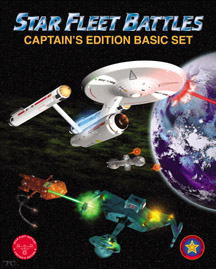
Star Fleet Battles (SFB) is a tactical board wargame set in an offshoot of the Star Trek setting called the Star Fleet Universe. Originally created in 1979 by Stephen V. Cole, it has had four major editions. The current edition is published by Amarillo Design Bureau as Star Fleet Battles, Captain's Edition.

Panzer General is a 1994 computer wargame developed and published by Strategic Simulations Inc. (SSI). It simulates conflict during World War II. The designers of Panzer General were heavily influenced by the Japanese wargame series Daisenryaku.
Strategic Simulations, Inc. (SSI) was a video game developer and publisher of over 100 games from its founding in 1979 to its dissolution in 1994. The company focused on computer wargames then later added role-playing video games. SSI published the Panzer General series and the official video game adaptations of Dungeons & Dragons.
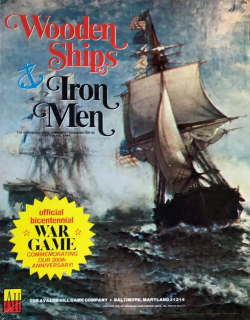
Wooden Ships and Iron Men is a naval board wargame simulating naval combat during the Age of Sail that was published by Battleline Publications in 1974, then revised and republished by Avalon Hill the following year.
Starfire is a board wargame simulating space warfare and empire building in the 23rd century, created by Stephen V. Cole in 1979.
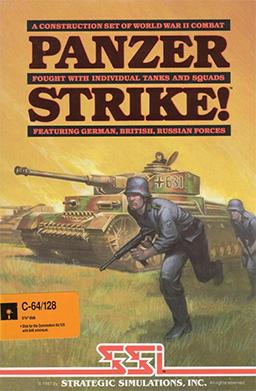
Panzer Strike is a 1988 tactical wargame that simulates small unit actions during World War II. It was made for Apple II and Commodore 64 and was released by Strategic Simulations.

Victory at Sea, subtitled "World War II Naval Combat Game", is a set of World War II naval wargaming rules published by Mongoose Publishing in 2006.

North Atlantic '86 is a computer wargame written by Gary Grigsby for the Apple II and published in 1983 by Strategic Simulations. The game covers a hypothetical conflict between NATO and the Soviet Union. A Mac version was released in 1986.
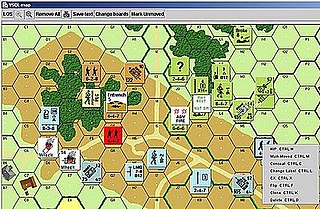
A computer wargame is a wargame played on a digital device. Descended from board wargaming, it simulates military conflict at the tactical, operational or strategic level. Computer wargames are both sold commercially for recreational use and, in some cases, used for military purposes.
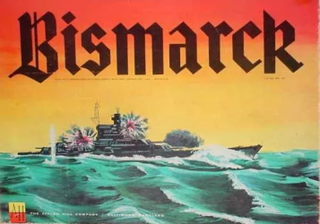
Bismarck is a board wargame published by Avalon Hill in 1962 that simulates the hunt for the Bismarck.

The Cosmic Balance II is a turn-based strategy game written by Paul Murray for the Apple II and published by Strategic Simulations in 1983. It was ported to the Atari 8-bit computers. The game is a sequel to The Cosmic Balance (1982) also designed by Murray.

Gary Grigsby's Pacific War is a 1992 strategy wargame released by Strategic Simulations, Inc. It covers World War II in the Pacific between the Japanese Empire and the Allies, which include the United States, the British Empire, the Netherlands, Australia, New Zealand, Canada, the Philippines, and China. The main map of the game stretches from north of the Aleutians to southern New Zealand and Australia, and from the eastern coast of India to the West Coast of North America. It includes aircraft carrier operations, amphibious assaults, surface bombardments/engagements, strategic bombing, kamikazes, and the submarine war against naval and merchant shipping.

Alpha Omega is a science fiction board wargame published by Battleline Publications in 1977 that simulates combat between alien and human space fleets. Avalon Hill acquired the game and republished it in 1980.

Chronicles of Osgorth: The Shattered Alliance is a computer wargame published in 1981 by Strategic Simulations for the Apple II and Atari 8-bit computers. Programmed by John Lyon, it relies on a new game engine, called RapidFire, intended to make faster and easier access to wargames published by the studio. During a turn, the program selects the units each in turn and the player only has to order them to move, attack or cast a spell. The order is then executed immediately before the program selects another unit. The game offers two categories of scenarios. The first is composed of medieval-fantasy confrontation, including a free adaptation of the Battle of Gondor against the Mordor forces in the Lord of the Rings. The second is composed of historical battles of antiquity.

Typhoon of Steel is a 1988 computer wargame designed by Gary Grigsby and published by Strategic Simulations Inc. (SSI) for the Apple II, Commodore 64, Amiga, and IBM PC. A follow-up to Grigsby's 1987 game Panzer Strike, it simulates military conflict during World War II.

Battle Group is a 1986 computer wargame designed by Gary Grigsby and published by Strategic Simulations. It is a follow-up to Grigsby's earlier Kampfgruppe.
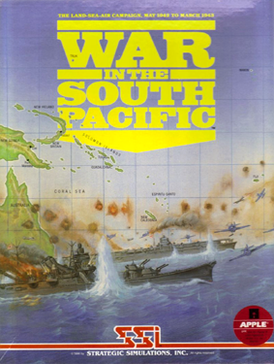
War in the South Pacific is a 1987 computer wargame designed by Gary Grigsby and published by Strategic Simulations. It is classified as a monster wargame.

Man of War, subtitled "A Game of Fleet Combat in the Age of Sail, 1775–1815", is a board wargame published by Simulations Canada in 1983 that simulates fleet and squadron naval engagements during the Age of Sail.

















